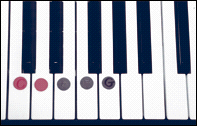|
|
:
Introduction 2008 |
|
The 2000 music assessments included nine assessment tasks related to re-creating music. Seven of the tasks were identical for year 4 and year 8 students, while the other two focussed on similar skills but were different in important detail for year 4 and year 8 students. Three are trend tasks (fully described with data for both 1996 and 2000), three are released tasks (fully described with data for 2000 only), and three are link tasks (to be used again in 2004, so only partially described here). Eight of the nine tasks were one-to-one interview tasks, with the ninth a team task. The task details and results for the trend tasks are presented in the first section, followed by the task details and results for the released tasks. The third section contains some task information and the results for the link tasks. Comparing
results for year 4 and year 8 students Trend
results: comparing 1996 and 2000 results Two trend tasks involving a total of 16 components were administered to year 8 students in both the 1996 and 2000 assessments. Some improvement was evident. Looking first at the most positive rating category for each component, there was improvement from 1996 to 2000 on 11 components, with on average five percent more students gaining the highest rating. Looking at the lowest rating category for each component, similar improvement was evident, with on average four percent fewer students gaining the lowest rating. The positive changes were very small for Vocal Sizzle but quite substantial for Keyboard Patterns. |
|||||
